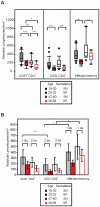The dual impact of HIV-1 infection and aging on naïve CD4 T-cells: additive and distinct patterns of impairment
- PMID: 21298072
- PMCID: PMC3027697
- DOI: 10.1371/journal.pone.0016459
The dual impact of HIV-1 infection and aging on naïve CD4 T-cells: additive and distinct patterns of impairment
Abstract
HIV-1-infected adults over the age of 50 years progress to AIDS more rapidly than adults in their twenties or thirties. In addition, HIV-1-infected individuals receiving antiretroviral therapy (ART) present with clinical diseases, such as various cancers and liver disease, more commonly seen in older uninfected adults. These observations suggest that HIV-1 infection in older persons can have detrimental immunological effects that are not completely reversed by ART. As naïve T-cells are critically important in responses to neoantigens, we first analyzed two subsets (CD45RA(+)CD31(+) and CD45RA(+)CD31(-)) within the naïve CD4(+) T-cell compartment in young (20-32 years old) and older (39-58 years old), ART-naïve, HIV-1 seropositive individuals within 1-3 years of infection and in age-matched seronegative controls. HIV-1 infection in the young cohort was associated with lower absolute numbers of, and shorter telomere lengths within, both CD45RA(+)CD31(+)CD4(+) and CD45RA(+)CD31(-)CD4(+) T-cell subsets in comparison to age-matched seronegative controls, changes that resembled seronegative individuals who were decades older. Longitudinal analysis provided evidence of thymic emigration and reconstitution of CD45RA(+)CD31(+)CD4(+) T-cells two years post-ART, but minimal reconstitution of the CD45RA(+)CD31(-)CD4(+) subset, which could impair de novo immune responses. For both ART-naïve and ART-treated HIV-1-infected adults, a renewable pool of thymic emigrants is necessary to maintain CD4(+) T-cell homeostasis. Overall, these results offer a partial explanation both for the faster disease progression of older adults and the observation that viral responders to ART present with clinical diseases associated with older adults.
Conflict of interest statement
Figures





References
-
- Mascolini M. What speeds aging with HIV-and what can be done about it? Research Initiative-Treatment Action! 2010;15:1–59.
-
- Desquilbet L, Jacobson LP, Fried LP, Phair JP, Jamieson BD, et al. HIV-1 infection is associated with an earlier occurrence of a phenotype related to frailty. J Gerontol A Biol Sci Med Sci. 2007;62:1279–1286. - PubMed
-
- Dorrucci M, Suligoi B, Serraino D, Tirelli U, Rezza G. Incidence of invasive cervical cancer in a cohort of HIV-seropositive women before and after the introduction of highly active antiretroviral therapy. J Acquir Immune Defic Syndr. 2001;26:377–380. - PubMed
Publication types
MeSH terms
Substances
Grants and funding
- U01 AI035042/AI/NIAID NIH HHS/United States
- R01 AI058845/AI/NIAID NIH HHS/United States
- 5-M01-RR-00722/RR/NCRR NIH HHS/United States
- U01-AI-35042/AI/NIAID NIH HHS/United States
- CA-16042/CA/NCI NIH HHS/United States
- U01-AI-37613/AI/NIAID NIH HHS/United States
- AI-28697/AI/NIAID NIH HHS/United States
- U01 AI035041/AI/NIAID NIH HHS/United States
- T32 CA009120/CA/NCI NIH HHS/United States
- U01-AI-35040/AI/NIAID NIH HHS/United States
- U01-AI-37984/AI/NIAID NIH HHS/United States
- U01 AI035043/AI/NIAID NIH HHS/United States
- U01-AI-35039/AI/NIAID NIH HHS/United States
- 5R01-AI-058845/AI/NIAID NIH HHS/United States
- U01 AI035039/AI/NIAID NIH HHS/United States
- 5 T32 CA009120/CA/NCI NIH HHS/United States
- U01 AI037984/AI/NIAID NIH HHS/United States
- U01-AI-35043/AI/NIAID NIH HHS/United States
- U01 AI037613/AI/NIAID NIH HHS/United States
- UO1-AI-35041/AI/NIAID NIH HHS/United States
- R01 AG030327/AG/NIA NIH HHS/United States
- M01 RR000722/RR/NCRR NIH HHS/United States
- P30 MH058107/MH/NIMH NIH HHS/United States
- P30 CA016042/CA/NCI NIH HHS/United States
- P30 AI028697/AI/NIAID NIH HHS/United States
- R01 AG032422/AG/NIA NIH HHS/United States
- 1R01-AG-030327/AG/NIA NIH HHS/United States
- U01 AI035040/AI/NIAID NIH HHS/United States
LinkOut - more resources
Full Text Sources
Medical
Research Materials

